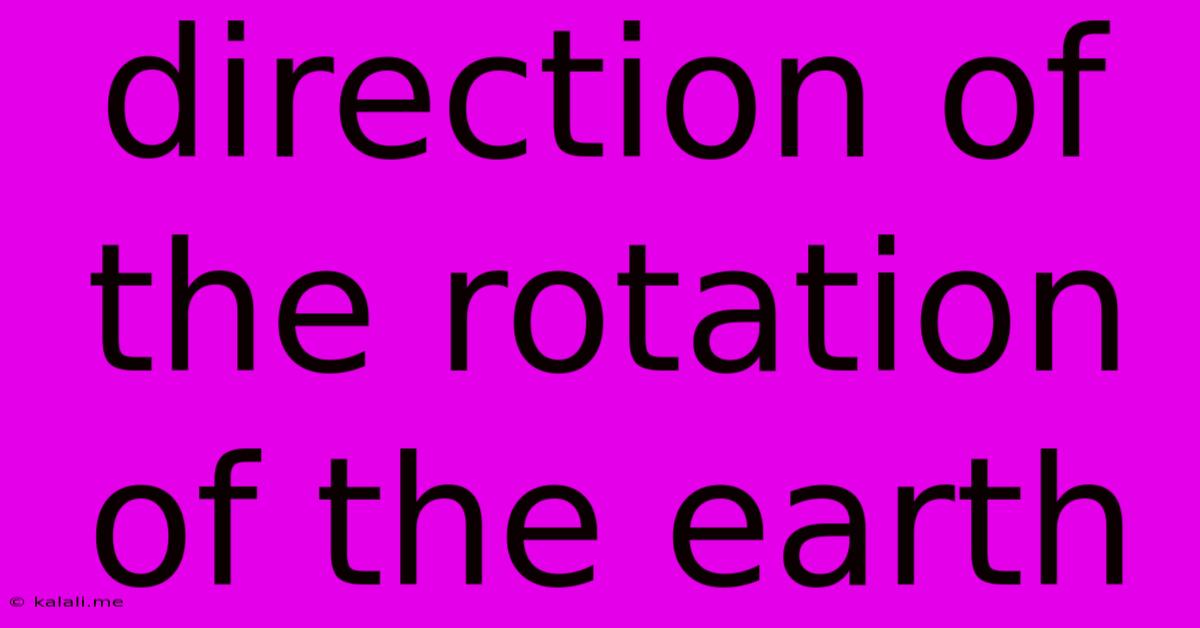Direction Of The Rotation Of The Earth
Kalali
May 09, 2025 · 3 min read

Table of Contents
The Earth's Rotation: Direction, Speed, and Consequences
The Earth's rotation is a fundamental aspect of our planet, shaping everything from day and night cycles to the Coriolis effect. Understanding the direction and speed of this rotation is crucial to comprehending many geophysical phenomena. This article delves into the specifics of Earth's rotation, exploring its direction, speed, and the significant consequences it has on our world.
Meta Description: Discover the fascinating direction of Earth's rotation, its speed, and the profound impact it has on our daily lives and global climate patterns. Learn about the Coriolis effect and the implications for weather systems.
The Direction of Earth's Rotation: West to East
The Earth rotates on its axis from west to east, a direction often described as counter-clockwise when viewed from the North Pole. This westward-to-eastward spin is responsible for the apparent movement of the sun, moon, and stars across the sky. Imagine standing at the North Pole and watching the Earth turn beneath you – you’d see everything rotating counter-clockwise. From the South Pole, the rotation would appear clockwise. This seemingly simple fact underpins the entire concept of day and night.
The Speed of Earth's Rotation: A Spinning Globe
The Earth completes one full rotation on its axis approximately every 24 hours. However, this isn't perfectly uniform. The speed isn't constant throughout the year due to several factors, including the gravitational influences of the sun and moon. While the average speed is approximately 1,000 miles per hour (1,600 kilometers per hour) at the equator, the rotational speed decreases as you move towards the poles. At the poles themselves, the rotational speed is effectively zero.
Consequences of Earth's West-to-East Rotation:
The Earth's rotation has profound consequences, impacting various aspects of our planet:
-
Day and Night Cycle: The most obvious consequence is the alternation of day and night, as different parts of the Earth face the sun. This cycle dictates the timing of sunlight and darkness, significantly influencing plant and animal life.
-
Coriolis Effect: This is a crucial impact affecting weather patterns and ocean currents. The Coriolis effect causes moving objects (like air and water) to be deflected to the right in the Northern Hemisphere and to the left in the Southern Hemisphere. This deflection significantly impacts the formation and direction of winds, ocean currents, and even the paths of projectiles. Understanding the Coriolis effect is essential for accurate weather forecasting and navigational purposes.
-
Apparent Movement of Celestial Bodies: The Earth's rotation makes it appear as though the sun, moon, and stars are moving across the sky from east to west. This apparent motion is crucial for our understanding of astronomy and timekeeping.
-
Tidal Bulges: While primarily caused by the gravitational pull of the moon, the Earth's rotation plays a role in the timing and intensity of tidal bulges. The rotation influences how quickly these bulges move across the ocean's surface.
-
Time Zones: The division of the world into time zones is directly based on the Earth's rotation. Each time zone roughly corresponds to a 15-degree slice of longitude.
Variations in Earth's Rotation:
It's important to note that the Earth's rotation isn't perfectly consistent. Slight variations occur due to several factors including:
-
Gravitational Interactions: The gravitational pull of the sun and moon causes slight changes in the Earth's rotation rate.
-
Core-Mantle Coupling: The interaction between the Earth's core and mantle can influence its rotational speed.
-
Seasonal Variations: Subtle changes in the distribution of mass on the Earth's surface due to seasonal changes in ice cover and atmospheric pressure also play a role.
These variations are typically measured in milliseconds and are constantly monitored by scientists using highly precise atomic clocks.
In conclusion, the Earth's rotation from west to east is a fundamental process that shapes our world in countless ways. From the simple cycle of day and night to the complex dynamics of weather patterns and ocean currents, the direction and speed of this rotation are integral to understanding our planet's environment and the intricate workings of our solar system.
Latest Posts
Latest Posts
-
50 Out Of 70 As A Percentage
May 09, 2025
-
Cuanto Es 99 0 Grados Fahrenheit En Centigrados
May 09, 2025
-
What Is 1 32 As A Decimal
May 09, 2025
-
What Percent Of 150 Is 90
May 09, 2025
-
1 3 Cup 1 3 Cup Equals
May 09, 2025
Related Post
Thank you for visiting our website which covers about Direction Of The Rotation Of The Earth . We hope the information provided has been useful to you. Feel free to contact us if you have any questions or need further assistance. See you next time and don't miss to bookmark.